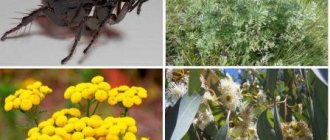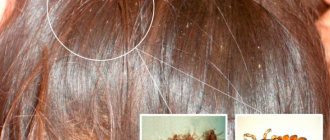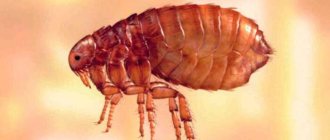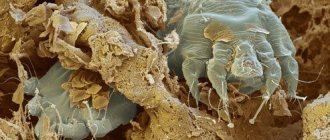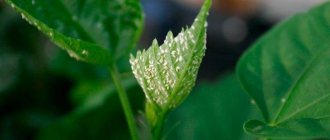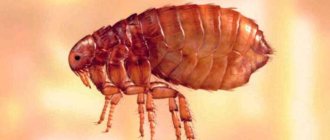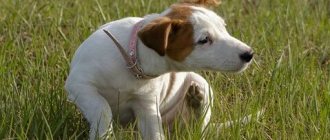Fleas are small blood-sucking parasites that cause a lot of trouble and inconvenience to both the animals themselves and their owners. The dog constantly itches and scratches itself until it bleeds; fleas can jump from animal fur onto the floor, climb on the floor, and walls. It is important to remember that dog fleas are not contagious to humans.
You can get rid of these annoying insects using pharmaceutical drugs or folk recipes. But will folk remedies be effective?
How to remove it using home methods?
These are time-tested techniques that will help clean your dog's fur. To make the procedure more effective, it is important to adhere to a number of rules.
- Before processing, it is necessary to comb out the animal's fur.
- Treat not only wool, but also bedding, carpets, and floor cracks. This will kill flea eggs and larvae.
- Place pine sawdust, lavender or wormwood on your dog's clean bedding. This will be an excellent prevention of re-infection.
- If there are other pets in the house, fleas should be treated for everyone at the same time.
There are many different recipes for preparing effective flea remedies. The simplest and safest thing is to use plants with a pungent odor:
- peppermint leaves;
- oregano;
- wormwood;
- tansy.
To prepare the product, 2-3 tbsp. of any raw material, pour 100-200 ml of boiling water and leave for 30 minutes. The herb wormwood or tansy can be additionally boiled over low heat for up to 10 minutes. Next, filter the solution, soak a cotton pad in it and wipe the animal’s fur. They leave it for 2-3 hours, then the animal needs to be bathed.
The next variation is the use of essential oils. Lavender, eucalyptus, tea tree, citronella, and cedar oil will be effective. The fighting mechanism is identical - the pungent smell repels parasites. You can mix the oils or use one: add 5-7 drops to shampoo or liquid soap, mix thoroughly and buy the dog.
Precautionary measures
Wormwood against fleas does not cause negative effects in dogs. The only exception may be individual intolerance to the plant. The use of the plant is contraindicated if there are people with allergies and asthmatics in the home. You should not bring wormwood into the apartment if, after it is in the room, sinusitis, rhinitis, otitis, or bronchitis begin in your household.
Caution should also be observed when treating a children's room; children may complain of dizziness and headaches. In this case, disinfection should be carried out in their absence.
What else should I treat to get rid of it?
| Name | Terms of use |
| Table or sea salt | The benefit of salt is that this substance destroys the chitinous membrane of insects The method of control is to bathe the dog in salt water.
|
| Camphor, table vinegar and cologne | This is a destructive mixture for any parasites. Combine the components in equal proportions. For better use, pour the resulting liquid into a spray bottle. Spray onto the animal's fur. Wait 10-15 minutes, do not let the animal lick itself. Then rinse well. |
| Boric acid | The fighting mechanism is that the substance disrupts the integrity of chitin, fleas die without their shell. The powder can be scattered around the house or diluted in water and sprayed onto the dog's fur. The product is completely safe for the animal. |
Answers to popular questions
Probably, almost every dog owner, when parasites appear in an animal, is interested in the following questions: how quickly fleas reproduce, what types of fleas can be found in dogs. As mentioned above, insects are not particularly picky in their diet; therefore, a dog can be attacked directly by dog fleas, rat fleas, human fleas, and many others. However, regardless of the species of insects, it is recommended to use similar preparations to remove them.
How does a pet become infected?
To somewhat protect your pet from parasite infection, it is important to know where fleas come from in dogs. More often, infection occurs through close contact between animals, for example, during play or fighting. However, there are many other ways. So, danger can lie in wait for a dog on the grass, earth, sand. Insects, falling from an infected animal into the external environment, can remain viable for a very long time.
Even if the animal practically does not go out for street walks (more often, keeping it exclusively in an apartment is necessary for puppies that do not have all the necessary vaccinations, as well as small breed dogs), there is a risk of infection.
This can happen upon contact with the owner's street shoes or the wheels of a baby stroller. That is, there are an incredible variety of ways to infect a dog with fleas.
Are fleas dangerous for humans?
Dog fleas may well pose some danger to humans. These parasites are not selective in their nutrition, that is, in the absence of an animal, they may well be considered a source of human nutrition.
Since fleas are carriers of serious diseases of infectious etiology, a parasite bite can cause the development of such dangerous ailments as typhoid, salmonellosis, and various types of helminthiasis. In order to avoid infection, you should begin removing parasites from an animal immediately after detecting signs of infection.
Is it safe to treat with these methods?
The main advantage of traditional methods over pharmaceutical drugs is safety. They can be used for puppies, pregnant and lactating bitches, and sick individuals.
But, in comparison with chemical means, folk remedies are less effective. To achieve the result, several treatments will be needed. In the presence of severe infection, folk recipes will be ineffective.
Generalized advantages of folk remedies for fleas:
- variety of recipes and uses;
- availability;
- low price;
- admissibility of carrying out at home without visiting a veterinarian.
Among the disadvantages are painstakingness, duration and regularity of treatments (there is no guarantee for a certain period, like with drops or collars), a sharp unpleasant odor that eats into the wool. Also, in some cases, there is a risk of developing an allergic reaction to the plant or product.
What is a flea
The “blood connection” between the ancestor of the dog and the flea arose even earlier than the appearance of Homo sapiens on earth - approximately fifty-five thousand years ago. Of the huge number of subspecies, the “dog flea” lives on dogs - a small (up to 5 mm) brown insect with a flattened body without wings. The structure of the body and three pairs of legs allow the parasite to easily jump on the “victim”, move quickly, hide in the fur, and, if necessary, jump to another owner or temporary carrier.
Important! Fleas reproduce quickly: the population increases to two hundred and fifty adults in a couple of weeks. The dog, its bedding, home carpets, and upholstered furniture are infected. They will also have to be processed.
How to eradicate puppies?
Puppies under 2 months of age are prohibited from using any chemical preparations for fleas, since their body cannot yet withstand the strong influence of poisons and insecticides (risks poisoning and even death). Therefore, before the age of 2 months, the fight against fleas consists of bathing and regular combing.
Also during this period, the use of some folk remedies is allowed.
Reference! One option for eliminating fleas in puppies is to use citrus peels.
They can be placed around the house (their smell repels fleas) or rubbed into the animal's fur and then rinsed off. You can treat a small pet’s fur with a weak infusion of mint or lavender, or bathe it with a special shampoo with the addition of essential oils. At the same time, carefully monitor that the puppy does not have an allergic reaction.
Folk remedies for fleas: effectiveness and application features
There are many remedies in the arsenal of traditional medicine that help get rid of parasites.
Tar soap
Tar soap consists of sodium salts (like all soaps), table salt and thickeners. The composition includes citric acid and birch tar. It is the latter substance that fights parasites. Tar also has an anti-inflammatory effect, eliminates itching and slightly dries the skin.
Birch tar is an effective remedy that is added to soaps, ointments and medicines for the treatment of inflammatory skin diseases, irritation, and redness. This substance has excellent repellent properties for insects, including fleas.
This natural product is suitable for repelling fleas on puppies, kittens, pregnant and lactating females. Even if wounds have formed on the skin of a dog or cat from constant biting and scratching, you can use tar soap.
This product, unlike specialized medications, is inexpensive and does not contain artificial flavors or dyes.
Our grandmothers used tar soap to remove fleas.
Recently we discovered fleas on our Cornish cat, and our couch potato cat has FLEAS!
Nightmare, horror and panic! Probably brought from the street. While going to the pet store - immediately wash the clothes/bedding, wash the cat... Yes, yes, we thoroughly wet it with warm water and thoroughly soap its paws/belly/sides with tar soap. Avoid ears and mucous membranes. Our disgruntled cat stood in the foam for a couple of minutes. The main thing is that it stopped itching and no one jumps on it (after 2 days, just in case, they washed it again). ArLety
https://irecommend.ru/content/degtyarnoe-mylo-dlya-menya-sredstvo-ot-perkhoti-i-molochnitsy-dlya-kota-sredstvo-ot-blokh-ta
One of my friends advised me to wash my dog with tar soap, there will be no skin problems, fleas and other nasty things.
That’s right, the fur was less itchy, he didn’t itch as much as before, we didn’t notice any fleas either, the lichen went away faster than expected, and in general the fur looked shiny and looked very healthy!!! Anna Fomkina
https://irecommend.ru/content/myli-sobaku
Herbs and plants for fleas
Plants such as tansy, chamomile and wormwood have proven themselves well in the fight against fleas.
There are a lot of herbs, the infusion of which helps protect your dog from fleas.
It can be tansy or ordinary wormwood. It won't be difficult to find her on the field. The smell is pungent, but there will definitely be no trace of fleas left. And the season for fleas is short, they usually only torment dogs in the summer, and when winter comes, that’s it. Fleas are afraid of the cold. Antonina
https://www.mydog.su/forum/narodnye-sredstva-ot-blokh-u-sobak
Sagebrush
To combat parasites, wormwood is used in several ways:
- 50 grams of dried wormwood are poured with a liter of boiling water and left for an hour. This infusion is added to bathing water for a sick animal or used to clean rooms where uninvited guests have settled;
- 25 g of dry grass are mixed with fresh raw materials (50 g), poured with water (0.5 l). Place on fire and let stand for several minutes, leave for 40 minutes. After filtering, spray the broth in the room, wash the floors, and also apply it pointwise to the animal’s fur, and then rub it with your hands;
- 2–4 teaspoons of herb are infused in 0.5 liters of vodka or alcohol for 2 weeks. The product is used for washing floors and furniture (10 ml of tincture per 1 liter of water);
- Wormwood powder and brooms are placed in hard-to-reach places in the house and apartment (in corners, attics and behind cabinets). The smell repels fleas and prevents re-infection of animals.
Wormwood is a plant from the Asteraceae family with a bright aroma and bitter taste.
The plant is not poisonous, it does not harm the health of the pet, it is only important to make sure that there is no allergy to the grass. In addition, the animal is unlikely to lick the fur, since preparations based on the plant have a bitter taste.
I had a similar story with parasites.
The cat suddenly got fleas (she doesn’t walk outside with me). I tried a lot on the poor animal, scoured the entire Internet and this is what I found out: flea control is not enough to get rid of parasites, you also need to treat the room, since fleas like to hide in the cracks of baseboards and parquet. So I bought a cat in an infusion of wormwood, put on a collar and moved in with a friend for a couple of days, and called exterminators into the apartment. Only after this did I manage to get rid of the fleas. Lera
https://www.woman.ru/home/animal/thread/4312013/
In our basement there are fleas living on stray cats, and when we go for cans, they inevitably end up in the house.
We got rid of it with the help of wormwood, we bought it at the pharmacy. We did it as the solution was written on the package, only to be sure, I doubled the dose, just to be sure, and sprayed the walls, carpets, and beds liberally. Then I washed the floors. I didn’t believe that it would help, but they left. kruchek_nv
https://forum.ditenok.com/showthread.php?t=34939
Chamomile
Chamomile can be used to control pests, but not ordinary chamomile, but Persian chamomile. The plant contains pyrethrins - substances that are effective in combating various insects. The closest relative of this herb is Caucasian chamomile. It is no less effective and easier to find.
Chamomile is used to combat fleas, but not ordinary chamomile, but Persian chamomile
The plant needs to be dried, crushed and scattered around the house, paying special attention to hard-to-reach places and animal beds. You can also lay out a fresh plant.
Persian chamomile is added to special insecticidal products for fleas (for example, Lugovoy shampoo).
Shampoo "Lugovoy" - a natural and modern flea remedy for dogs and cats
It’s better not to put chamomile, but wormwood.
We used to even put it in the dog’s kennel in the village, and somehow we had to treat the sofas at home. But this is the safest way, otherwise everything needs to be processed. Lyra
https://www.nn.ru/community/my_baby/my_baby/blokhi_v_kvartire-_ili_kak_ya_skhozhu_s_uma.html
Tansy
The essential oils contained in this plant repel fleas with their scent. To get rid of parasites, stems with inflorescences are used both fresh and dried (30 grams of inflorescences or dry tansy powder per glass of boiling water).
Some sources recommend wiping the pet’s fur and skin with the resulting product and using the liquid to clean the premises.
It is worth noting that an infusion of flowers effectively copes with parasites only if the flea is completely immersed in a product that is dangerous to it, so it is much more effective to bathe your pet in a medicinal bath with tansy (the liquid is prepared in the same proportion). As for treating premises, this remedy is suitable for prevention, but its usefulness for getting rid of parasites is questionable.
Targeted use of the infusion is ineffective: the parasites simply move from one place to another.
The bright yellow plant, found throughout the country, is an excellent flea repellent for pets.
I tried to use tansy and wormwood, other “flavors”.
But what causes fleas to run away can it be harmless to a dog? I learned that you can use stove ash (not to be confused with soot) to control fleas. In my opinion, this is completely unacceptable for a dog. Moreover, fleas have already adapted to modern ecology. My “dog” experience tells me that we need to stop doing experiments on our pets. I am for modern means of protecting dogs. Anvani
https://www.mydog.su/forum/narodnye-sredstva-ot-blokh-u-sobak
Garlic
Fragrant cloves are placed in corners, on shelves, in cabinets and on baseboards to scare away unexpected guests. An infusion is prepared from garlic (for wet cleaning) or scattered around the apartment in crushed form.
Tomorrow I’ll go looking for neostomozan, otherwise I’m already tired of scattered garlic around the apartment) although it helps.
Daria
https://www.woman.ru/home/medley9/thread/3852484/6/
Bay leaf
The fragrant seasoning is used both in dry form and in the form of tincture. Dry leaves are laid out in corners and crevices to repel parasites throughout the house, and the infusion (10 grams of leaves per glass of boiling water) is sprayed on the home.
Essential oils for fleas
Essential oils can be used effectively to treat rooms when treating pets.
Most often, oils are used in the form of a suspension by mixing the selected product with some water.
Add 25 drops of oil to five liters of water. The resulting solution is used to treat shelves, baseboards, and floors. After filling the spray bottle with the product, treat furniture, curtains and corners in the apartment that are difficult to clean with a rag and vacuum cleaner.
The following oils are suitable for preparing the solution:
- lavender;
- mint;
- tea tree;
- carnations;
- eucalyptus;
- anise;
- cedar;
- pine trees;
- thyme;
- wormwood.
Oil is also poured into small open bowls or jars and placed around the house. The smell repels pests, and they run away in search of a new home.
Essential oils have strong antiseptic and insecticidal properties due to the plant substances they contain.
Oils are not only well suited for treating premises, but are also used as drops on the withers. Use such homemade “drops” with extreme caution, as if they get into the mouth they can cause serious consequences and cause a loss of smell in tailed pets.
When using oils for cleaning or as medicine for the first time, be sure to perform an allergy test. Oils should not be used in a home where there are pregnant women and small children.
Oils of bergamot, eucalyptus, geranium, lavender and others are effective insect repellents, and when using them, you can even completely abandon synthetic flea products for dogs and cats.
It is enough to wipe the animal's fur with one or two drops of oil. Dogs are generally more tolerant of this type of grooming than cats, and their fur can be rubbed or combed with a mixture of these oils diluted in oil and then water. For cats, it is better to use lavender oil. Rub a couple of drops of oil in your palms and simply stroke the cat. Some cats will tolerate this procedure without objection, but others may not like it. If you have a fluffy cat, then put some oil on the brush you use to brush it. The same method can be used on a dog if you don't want to get its fur wet. Patricia Davis
Aromatherapy from A to Z
Lavender oil is a pleasant and useful remedy for the treatment and prevention of fleas in pets.
This is nonsense... I took SO many of these ampoules and once I even got poisoned myself, but after a couple of weeks it all started all over again... But what helped was COCONUT OIL!!!
Refined, deodorized, absolutely safe for us warm-blooded people, I bought it where everything for soap making at home is sold, I smeared it on my cats and the floor and that’s it! no more problem! It is also anthelmintic, so when cats licked it off they were also prevented from these parasites. Since my cats go outside, I repeat the procedure once a month. SVT
https://forumodua.com/showthread.php?t=484346
I treated my dog for fleas with a mixture of lavender and tea tree.
It seems they don’t download Cerise
https://forum.aromarti.ru/archive/index.php/t-937.html
How to remove it from pregnant and lactating women?
Pregnant and lactating bitches are allowed to use almost all folk remedies. But you need to use caution (or better yet abstain for a while) from recipes containing aggressive ingredients.
- Compositions based on hydrogen peroxide. There is a risk of burns to the mucous membranes, and the substance also has a bad effect on the coat, it becomes lighter and duller.
- Hellebore water, since it is based on the poisonous herb hellebore and alcohol (dangerous, since the liquid can be absorbed into the skin).
- Ammonia and kerosene.
- Any compositions based on table vinegar.
general description
There are about 2 thousand species of these small blood-sucking creatures. Regarding those species that attack dogs specifically, these include canine, feline, human pastel, suction and penetrating. They live for about a year and a half, reproduce very quickly, the breeding cycle is no more than 25 days.
The diet of canine parasites consists of animal blood. They pose a great danger to animals, since parasites carry dangerous diseases and helminths. In addition, due to severe itching, animals scratch their skin and damage it; the wounds often get infected, which leads to inflammation, rotting and the development of diseases.
When treatment for fleas is carried out, attention should be paid not only to treating the pet, but also to its bedding, places where it spends a lot of time, and toys. Since not only adult individuals can be found there, but also their larvae. These blood-sucking creatures do not constantly parasitize the body of the victim, they drink blood and leave the body, so they lay their offspring throughout the apartment.
For this reason, in case of severe infestation, it is necessary to treat the room to prevent re-infestations. When several animals live in an apartment, it is necessary to treat all of them at once. Folk remedies can be used for both dogs and cats. In addition, traditional methods can be combined with specialized medications.
Review Reviews
Most dog owners note the safety and availability of traditional recipes. Below are the main extracts from real reviews on special sites for dog breeders.
- Veronica from Moscow says that regularly treating an animal's fur with a rich infusion of wormwood helped get rid of large colonies of fleas. The procedure had to be repeated 3 times with an interval of 4 days, but the result was the same as from pharmaceutical poisons, but there was less harm to the animal’s body.
- Victor from Rostov notes that folk products are suitable for small or medium-sized dogs. He is the owner of a German Shepherd, and using homemade recipes is labor-intensive and ineffective.
- Victoria from Orel highlights the benefits of essential oils. Every time you bathe your dog (Labrador), she applies a few drops of various fragrant oils to the pet’s fur. This serves as an excellent flea prevention: the oil kills eggs and larvae.
Prevention
To ensure that fleas visit your dog much less often, you must follow these rules:
- Periodically disinfect the room, change and wash sleeping places;
- Vacuum carpets, cracks in the floor, burn disposable dust containers, and put an anti-flea collar in a reusable one;
- Keep contact with other animals to a minimum;
- Monitor your pet's behavior;
- Brush his coat regularly, preferably with a flea comb or a metal comb with firm, fine-toothed teeth;
- Walk in specially designated areas;
- Keep calamus leaves or branches of wormwood and tansy in the corners of the house, but only if the pet does not have allergies;
- Ventilate the house in winter - fleas cannot stand the cold;
- During the summer months, wear a flea collar before going for a walk;
- Be sure to examine the dog after mating or upon returning from a show.
If fleas are found on one of your pets, you will have to treat every single one of them, even if they show no signs. This is a necessary part of prevention.
Some owners begin to fight parasites only if they have already multiplied with might and main. They believe that fighting small insects is the same as going to drink tea. Indeed, sometimes this turns out to be simple, especially if the house is small and there is only one dog living in it. But we must remember that the struggle is not always easy, and the pet can literally experience agony.
Taking flea prevention is the responsibility of every dog owner.
Cooking recipes
There are many ways to take bitter wormwood for parasites. Most often the powder is consumed in dry form. To remove worms, you need to grind dried flowers, leaves, stems, and roots to a powder or use ready-made commercial powder. Based on the powder, decoctions, infusions, and oil solutions are prepared. You can also consume the herb in dry form with water, tea, or soften the bitterness with honey or sugar.
Decoction
To obtain a decoction, pour 1 tablespoon of wormwood into 1 glass of boiling water. The resulting mixture is placed in a water bath for a quarter of an hour. The finished broth is cooled to room temperature, strained and taken several times a day.
A decoction is the most convenient way to use wormwood.
Tincture
The medicinal qualities of the herb are perfectly manifested in alcohol-based tinctures. To prepare you will need 200 g of crushed pumpkin seeds, 200 g of powdered wormwood and 600 g of vodka. The resulting infusion is thoroughly mixed and infused for 1 week in a cool, dark place.
Oil
Wormwood oil is obtained by pressing the stems, roots and flowers with the addition of olive oil. The herbs are placed in a vessel, poured with oil, tightly closing the container with a lid. The composition is left for 30 days in a dark place. After this period, the oil is completely ready for use. It can be taken either ready-made or added to various dishes.
Enemas
Enemas from the plant must be given daily for 1 week. For 2 liters of water – 1 tablespoon of wormwood. Pour boiling water over the herb and leave on the stove for 10 minutes. The infusion is cooled to 40 degrees and filtered. Cleansing enemas are used hot.
Wormwood and cloves
An effective folk recipe against helminthic infestation is a mixture of wormwood and clove powder. For better results, flax seeds are added to the composition. The ingredients are ground into powder and mixed in equal parts. The herbs should be taken with freshly squeezed carrot juice. It is the combination of wormwood and cloves that achieves the best effect on adults, their eggs and larvae.
Wormwood and tansy
Tansy grass, which has bactericidal properties, is also used to remove helminths from the body. It can be used as an independent remedy or as part of a complex treatment. The combination of tansy and wormwood will help eliminate worm eggs in a short time. Most often, in case of mixed invasion, a “triad” is used, consisting of tansy, cloves and wormwood. For preparation you will need dry herbs: 100 g tansy, 50 g cloves, 30 g wormwood. The ingredients are crushed, mixed and consumed in powder form with water.
DIY anti-flea shampoo
This is a fairly effective remedy for removing fleas and ticks from animals. The shampoo is prepared as follows:
- a quarter of a piece of baby soap is grated and filled with 350 ml of warm water;
- the mixture is brought to a jelly-like state over heat;
- After the jelly has cooled, add chopped onion, egg yolk, and a few drops of nettle infusion.
The resulting infusion should be lathered on the pet and left for twenty minutes. After this, rinse the solution thoroughly, dry and comb the animal.

